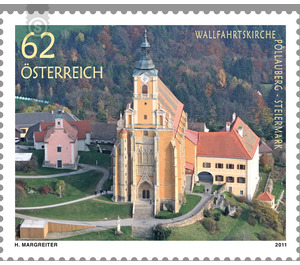churches - Austria / II. Republic of Austria 2011 - 62 Euro Cent
Theme: Architecture
| Country | Austria / II. Republic of Austria |
| Issue Date | 2011 |
| Face Value | 62.00 |
| Edition Issued | 320,000 |
| Printing Type | offset |
| Stamp Type | Commemorative |
| Item Type | Stamp |
| Chronological Issue Number | 2273 |
| Chronological Chapter | OOS-OE2 |
| SID | 619637 |
| In 53 Wishlists | |
With the new special stamp "Pilgrimage Church Pöllauberg" the popular series "Churches from Austria" now finds its attractive continuation. The motif shows the impressive church "in all its glory", embedded in the lovely landscape of the hilly eastern Styria. History: The pilgrimage to Pöllauberg began at the end of the 12th and early 13th centuries with the worship of a statue of Mary. At that place, where the Annakirche stands today, was once a Romanesque chapel, which was visited mainly on Saturdays, which gave the mountain the name "Saturday Mountain". Around 1340 began the construction of today's pilgrimage church Maria Pöllauberg in the Gothic style. Founder was Katharina von Stubenberg. Noteworthy in the construction of the church is mainly the two-nave nave with three yokes and a magnificent ribbed vault, choir and porch, however, are extended to three ships. The church is located below the original chapel on a three-sided steep hill, so that the mighty structure had to be built partly even over the mountain. The main portal in the west is only accessible via 18 steps; Finally, in 2009, a barrier-free access was set up on the left-hand side, allowing access from the Hauptplatzweg without steps. The walls of the church are mostly made of untreated quarry stone, only the west facade was made of house stones. The total length of the church is more than 37 meters, the width is almost 14 meters. The decor of the interior contains, in addition to several other valuable works of art, a gothic statue of the Virgin Mary from the 15th century - the largest part of the church's inventory comes from the Baroque. The beautiful high altar, which in its richness is an expressive creed, was erected by Max Schkotnigg and his son Joseph between 1710 and 1730, the organ in the loft with rich stucco dates from 1684. Around the same time, the Gothic church tower was built destroyed by a lightning strike and later replaced by a baroque tower, in 1872 it was extended by a cross. Even today, the Pöllauberg is one of the most important places of pilgrimage in Styria and is visited year after year by about 100,000 faithful for worship and inner retreat.


